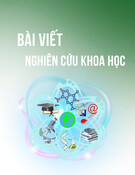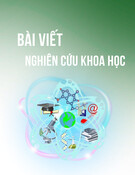
VNU Journal of Science: Education Research, Vol. 40, No. 2 (2024) 81-89
81
Original Article
Application EON-XR Virtual Reality Technology
in the Design of Biology Learning 10th Grade
Nguyen Thi Thuy Quynh1,*, Kim Thi Luong2
1VNU University of Education, 144 Xuan Thuy, Cau Giay, Hanoi, Vietnam
2Phan Huy Chu High School, Quoc Oai, Hanoi, Vietnam
Received 22 February 2023
Revised 06 May 2024; Accepted 05 June 2024
Abstract: Knowledge of the Cell biology section Biology 10 includes content covering the
structure of prokaryotic and eukaryotic cells. These structures can only be observed under a
microscope and cannot with the eye. Currently, many 3D virtual reality (VR) image simulation
applications can assist in teaching at the cellular and molecular levels. Through the outstanding
feature of 3D image simulation, EON-XR is an effective support tool in teaching biological
structures and processes. Learners can approach Biology knowledge in a more vivid way, easily
visualize and have accurate concepts about images, things and phenomena when interacting with
them like in the real environment. In this study, the application of EON-XR virtual reality
technology was introduced and a number of products were designed to support the teaching of Cell
Biology. A 5-steps process was developed when designing a teaching plan that applies virtual
reality technology. Pedagogical experiments were conducted with experimental classes (classes
with VR applications) and control classes (teaching using traditional methods). The results show
that the student’s information technology competency learning on the VR platform is higher in the
experimental classes than in the control class. At the same time, the EON-XR virtual reality
application can help students deepen their understanding of knowledge. Designing Biology
teaching activities with VR applications helps improve the quality of teaching in high schools and
meet current educational innovation requirements.
Keywords: Cells, EON-XR, virtual reality, biology 10, information technology capacity.
D*
_______
* Corresponding author.
E-mail address: quynhntt-bio@vnu.edu.vn
https://doi.org/10.25073/2588-1159/vnuer.4735

N. T. T. Quynh, K. T. Luong / VNU Journal of Science: Education Research, Vol. 40, No. 2 (2024) 81-89
82
Ứng dụng công nghệ thực tế ảo EON-XR trong thiết kế
bài giảng phần sinh học tế bào, môn sinh học 10
Nguyễn Thị Thuý Quỳnh1,*, Kim Thị Lương2
1Trường Đại học Giáo dục, Đại học Quốc gia Hà Nội, 144 Xuân Thủy, Cầu Giấy, Hà Nội, Việt Nam
2Trường Trung học Phổ thông Phan Huy Chú, Quốc Oai, Hà Nội, Việt Nam
Nhận ngày 22 tháng 02 năm 2023
Chỉnh sửa ngày 06 tháng 5 năm 2024; Chấp nhận đăng ngày 05 tháng 6 năm 2024
Tóm tắt: Kiến thức phần Sinh học tế bào, Sinh học 10 gồm các nội dung bao hàm về cấu trúc của
tế bào, tế bào nhân sơ và nhân thực. Những cấu trúc này chỉ có thể quan sát dưới kính hiển vi và
không thể quan sát bằng mắt thường. Hiện nay, nhiều ứng dụng mô phỏng hình ảnh dưới dạng 3D
thực tế ảo (VR) có thể hỗ trợ trong dạy học các cấu trúc ở cấp độ tế bào và phân tử. Điều này giúp
người học có thể tiếp cận với kiến thức Sinh học một cách sinh động, dễ dàng hình dung các hình
ảnh, sự vật, hiện tượng khi tương tác với chúng như trong môi trường thực. Trong nghiên cứu này,
ứng dụng công nghệ thực tế ảo EON-XR đã được giới thiệu và thiết kế một số sản phẩm thực tế ảo
hỗ trợ trong dạy học phần Sinh học tế bào. Quy trình gồm 5 bước đã được xây dựng khi thiết kế kế
hoạch dạy học có áp dụng VR. Thực nghiệm sư phạm được tiến hành với các lớp thực nghiệm
(tiết học có ứng dụng VR) và lớp đối chứng (dạy học theo phương pháp truyền thống). Kết quả cho
thấy với năng lực công nghệ thông tin của học sinh học trên nền tảng VR ở các lớp thực nghiệm
cao hơn với lớp đối chứng. Đồng thời, ứng dụng thực tế ảo EON-XR có thể giúp học sinh hiểu sâu
hơn kiến thức và tăng hứng thú với môn học. Việc thiết kế các hoạt động dạy học môn Sinh học có
ứng dụng VR giúp nâng cao chất lượng dạy học ở trường phổ thông và đáp ứng với các yêu cầu
đổi mới giáo dục hiện nay.
Từ khóa: Tế bào, EON-XR, thực tế ảo, sinh học 10, năng lực công nghệ thông tin.
1. Mở đầu *
Thực tế ảo (VR) được ứng dụng phổ biến
trong lĩnh vực giáo dục và trở thành một xu
hướng quan trọng trong thời đại 4.0, giúp người
học được trải nghiệm trong môi trường tương
tác và sống động. Xu hướng ứng dụng công
nghệ thực tế ảo đã được triển khai trong các
trườngK-12 tại Mỹ và nhiều quốc gia khác trên
thế giới. Tại Việt Nam hiện nay, thực tế ảo ứng
dụng trong giáo dục đã và đang được một số
trường chú trọng phát triển và ứng dụng trong
dạy học tuy nhiên con số này còn rất khiêm tốn.
Chương trình giáo dục phổ thông 2018
được xây dựng theo định hướng phát triển
_______
* Tác giả liên hệ.
Địa chỉ email: quynhntt-bio@vnu.edu.vn
https://doi.org/10.25073/2588-1159/vnuer.4735
phẩm chất và năng lực của người học thông qua
tiếp cận các phương pháp dạy học tích cực giúp
học sinh hứng thú hơn với môn học và có thể
định hướng nghề nghiệp cho bản thân [1]. Cho
đến thời điểm hiện tại, rất ít những công trình
nghiên cứu ứng dụng thực tế ảo trong việc dạy
học chương trình phổ thông trên thế giới và tại
Việt Nam. Do đó, bài báo nghiên cứu và đề
xuất quy trình trong thiết kế kế hoạch dạy học
môn sinh học lớp 10 có áp dụng thực tế ảo.
Công nghệ thực tế ảo EON-XR được xem một
công cụ hỗ trợ đắc lực trong dạy học sinh học
với nhiều mô hình 3D có các nội dung như cấu
trúc cấp độ phân tử, cấp độ tế bào cũng như quá
trình sinh học [2]. Thông qua ứng dụng này,
người học có thể tiếp cận với kiến thức một cách
hiệu quả hơn và giúp học sinh phát triển năng lực
tự học, tự nghiên cứu; nhận xét, đánh giá và năng
lực công nghệ thông tin [3, 4].

N. T. T. Quynh, K. T. Luong / VNU Journal of Science: Education Research, Vol. 40, No. 2 (2024) 81-89
83
Bài báo đã đề xuất một qui trình thực hiện
thiết kế bài giảng môn Sinh học 10 sử dụng
công nghệ VR nguồn dữ liệu có sẵn EON-XR.
Tính khả thi việc ứng dụng công nghệ thực tế
ảo trong dạy học sinh học thông qua thực
nghiệm sư phạm đối với các lớp thực nghiệm
có sử dụng thực tế ảo và lớp đối chứng dạy theo
phương pháp truyền thống.
2. Thực nghiệm
2.1. Ứng dụng công nghệ thực tế ảo trong dạy học
Trong lĩnh vực giáo dục, xu hướng ứng
dụng công nghệ thực tế ảo (bao gồm cả thực tế
ảo tăng tường, AR) trong các trường K-12 tại
Mỹ và nhiều quốc gia khác trên thế giới [5]. Khi
ứng dụng VR/AR trong dạy học giúp cho người
học hứng thú hơn, chú ý đến vấn đề nhiều hơn,
thể hiện mức độ tập trung cao hơn so với các lớp
học thông thường [6].
Một số nghiên cứu ở trường đại học tại Việt
Nam cũng cho thấy việc ứng dụng VR đã khắc
phục được các hạn chế của phương pháp giảng
dạy truyền thống, cho phép tạo các mô hình mà
người học có thể tương tác, quan sát,... thay vì
phải học các khái niệm trừu tượng hay những
quy trình kỹ thuật phức tạp [7]. Ở cấp phổ
thông, một số đề xuất phương án ứng dụng thực
tế ảo trong dạy học môn hoá học và vật lý đã
đưa phòng thí nghiệm ảo giúp học sinh trải
nghiệm các bước tiến hành thí nghiệm khoa học
tương tự như phòng thí nghiệm thực trong môi
trường ảo [8-10].
Năm 2023, nhóm nghiên cứu
đến từ trường Đại học giáo dục đã nghiên cứu và
sử dụng ứng dụng EON-XR
mô phỏng quá trình
phòng chống COVID-19 và các bệnh truyền
nhiễm nguy hiểm cho tr mầm non [4].
Cho đến thời điểm hiện nay, các tài liệu
nghiên cứu về ứng dụng VR/AR trong dạy học
sinh học còn hạn chế. Do đó, bài báo này hướng
tới giới thiệu phần mềm ứng dụng thực tế ảo
EON-XR trong thiết kế các bài giảng sinh học
giúp người học được tiếp cận với một kỹ thuật
hiện đại cũng như giúp học sinh phát triển được
năng lực công nghệ thông tin.
EON-XR là một ứng dụng với nguồn tư liệu
mô hình 3D lớn nhất thế giới dành cho mục
đích giáo dục và doanh nghiệp. Người dùng có
thể chọn các mô hình 3D phù hợp để tạo các bài
học chuyên sâu trên các thiết bị phổ biến, từ
điện thoại thông minh đến máy tính xách tay.
Điều thú vị là ứng dụng này có thể tích hợp các
tính năng như ghi âm giọng nói, chú thích
chuyển văn bản thành giọng nói, đăng tải video,
tạo câu hỏi kiểm tra,…
2.2. Năng lực công nghệ thông tin của học sinh
Đối với học sinh, năng lực công nghệ thông
tin được xem là một năng lực chung bắt buộc
phải có, bởi l công nghệ thông tin là một thành
một phần tất yếu của cuộc sống hiện đại trong
kỷ nguyên số hiện nay. Năng lực công nghệ
thông tin là một trong những năng lực thiết yếu
trong thế kỷ 21 và đã được UNESCO khng
định học sinh cần phải làm chủ công nghệ để
đáp ứng được sự thay đổi và phát triển của xã
hộI [7].
Bài báo tiến hành đánh giá năng lực công
nghệ thông tin của học sinh, thông qua một số
thành tố cụ thể như sau:
i) Học tập có s dụng sự hỗ trợ các phưng
tiện k thuật: sử dụng phương tiện kĩ thuật
thông thường trong học tập như máy tính, máy
chiếu, điện thoại thông minh,… Nhận biết được
các thành phần của một hệ thống máy tính, biết
và sử dụng thành thạo các phần mềm hỗ trợ học
tập cơ bản như Word, Excel, PowerPoint,...;
ii) Giải quyết nhiệm vụ nhờ sự trợ giúp của
công nghệ thông tin Biết tổ chức và lưu trữ dữ
liệu trong các thiết bị khác nhau, khai thác
thành thạo mạng Internet, xác định được mối
liên hệ giữa thông tin tìm được và dùng các
thông tin đó để giải quyết các nhiệm vụ học tập;
iii) Ứng x có phù hợp với chuẩn mực đạo
đức trong xã hội số hóa: đồng thời có kiến thức
về sử dụng công nghệ thông tin để chia s, trao
đổi thông tin, hợp tác với giáo viên và bạn học
một cách an toàn và hiệu quả.
Để hình thành và phát triển năng lực công
nghệ thông tin cho học sinh, giáo viên cần sử
dụng công nghệ thông tin trong các hoạt động
giảng dạy trong lớp học thì học sinh s tăng cơ
hội sử dụng, khai thác hơn việc chỉ là khán giả
của việc trình chiếu sản phẩm của giáo viên.
học sinh s được tham gia sử dụng công nghệ
thông tin để để giải quyết các nhiệm vụ được

N. T. T. Quynh, K. T. Luong / VNU Journal of Science: Education Research, Vol. 40, No. 2 (2024) 81-89
84
giao trong quá trình học tập, từ đó giúp học sinh
rn luyện và nâng cao năng lực công nghệ
thông tin. Do đó, đổi mới phương pháp dậy học
đặt học sinh vào tình huống là người làm chủ
hoạt động học tập có sử dụng các phương tiện
kĩ thuật hiện đại hỗ trợ cho quá trình học tập.
Đặc biệt, giáo viên phải là người định hướng,
thiết kế các hoạt động phù hợp: vừa sức nhưng
lại đầy thách thức để dn dắt học sinh tự mình
trải nghiệm, tự mình khám phá và chiếm lĩnh
kiến thức môn học.
2.3. Thiết kế kế hoạch dạy học bằng ứng dụng
công nghệ thực tế ảo EON-XR
2.3.1. Quy trình thiết kế
Quy trình thiết kế kế hoạch dạy học có áp
dụng công nghệ thực tế ảo được đề xuất gồm 5
bước với các mô tả chi tiết cho các bước (Hình 1).
h
Hình 1. Quy trình thiết kế kế hoạch dạy học ứng dụng công nghệ thực tế ảo EON-XR.
Bước 1:
Nghiên cứu và lựa chọn nội dung kiến thức
các bài học phù hợp có thể ứng dụng công nghệ
thực tế ảo.
Bước 2:
i) Tìm hiểu nội dung hình ảnh/mô hình 3D
có trong ứng dụng EON-XR;
ii) Lựa chọn hình ảnh 3D phù hợp.
Bước 3:
i) Xác định mục tiêu bài học;
ii) Lựa chọn phương pháp dạy học phù hợp;
iii) Tìm kiếm tài liệu làm tài nguyên học liệu;
iv) Xây dựng kế hoạch dạy học có sử
dụng thực tế ảo;
v) Xây dựng nhiệm vụ học tập có sử dụng
thực tế ảo thực hiện các mục tiêu bài học.
Bước 4:
Giai đoạn 1:
+ Giới thiệu nội dung bài học.
+ Giới thiệu và hướng dn học sinh sử dụng
ứng dụng VR với các nhiệm vụ trong từng tiết học.
Giai đoạn 2: thực hiện dạy tiết thực nghiệm
theo kế hoạch đã xây dựng.
Bước 5:
Đánh giá và điều chỉnh những nội dung
trong kế hoạch dạy học cho phù hợp.
2.3.2. Nguyên tắc ứng dụng thực tế ảo thiết
kế bài giảng sinh học 10
Đm bo mc tiu mn hc:
Việc sử dụng thực tế ảo trong nhà trường ở
Việt Nam góp phần thực hiện mục tiêu về ứng
dụng công nghệ thông tin trong nhà trường
được quy định trong Chương trình Giáo dục
phổ thông năm 2018 và các Chỉ thị, Quyết định
của Thủ tướng Chính phủ, của Bộ Giáo dục và
Đào tạo về chuyển đổi số và tăng cường ứng
dụng công nghệ thông tin trong dạy học. Do đó,
ngoài ứng dụng VR tạo hứng thú, phát huy tính
tích cực học tập, chủ động sáng tạo, huy động tối
đa các giác quan cho
học sinh
và nâng cao chất
lượng giảng dạy thì mô hình
thực tế ảo
cần gắn
liền với nội dung bài học, đảm bảo thực hiện theo
mục tiêu môn học.
Hnh thnh v pht trin nng lc công
nghệ thng tin cho
hc sinh
:
Ứng dụng công nghệ VR/AR vào dạy học
khoa học tự nhiên khiến bài giảng sinh động
hơn và học sinh quan sát trực quan, tiếp thu
kiến thức dễ dàng tại lớp học và phát triển năng
lực công nghệ thông tin (NL CNTT) cho học
sinh. Năng lực này được xem là khả năng phù
hợp với một cá nhân để sống, học tập và làm
việc trong kỷ nguyên số hiện nay.

N. T. T. Quynh, K. T. Luong / VNU Journal of Science: Education Research, Vol. 40, No. 2 (2024) 81-89
85
Đm bo tnh thm m v gio dc:
Các ứng dụng của
EON-XR với những hình
ảnh 3D trực quan bắt mắt giúp học sinh tiếp thu
bài học tốt hơn.
Nguyên tắc này giúp
giáo viên
thiết kế, lựa chọn mô hình VR/AR phù hợp, đảm
bảo thực hiện được cả nhiệm vụ dạy học là trí dục,
phát triển và giáo dục.
2.3.3. Thiết kế một số sản phẩm thực tế ảo
nhờ công nghệ EON-XR
Ứng dụng thực tế ảo trong dạy học đóng vai
trò quan trọng trong việc đổi mới phương pháp
giáo dục hiện đại. Tại các cơ sở đào tạo các cấp
học khác nhau, người học đều được trải nghiệm
và quan sát thông qua việc tương tác với sự hỗ trợ
của công nghệ VR, và đạt được các phẩm chất và
năng lực cần có của chương trình đào tạo [5].
Trên nền tảng ứng dụng EON-XR, một số
các hình ảnh 3D liên quan đến nội dung kiến
thức đáp ứng trong dạy học môn Sinh học.
Trong quá trình nghiên cứu và phân tích nguồn
tài nguyên mở trên các ứng dụng EON-XR,
chúng tôi nhận thấy có một số các dữ liệu phù
hợp với nội dung kiến thức chương trình Sinh
học 10. Tuy nhiên, cần có sự nghiên cứu và phân
tích nội dung chương trình, từ đó lựa chọn các
hình ảnh 3D phù hợp với chương trình phổ thông
hiện hành. Trong khuôn khổ bài báo này, chúng
tôi đề xuất một số ví dụ về sản phẩm VR/AR
trong ứng dụng EON-XR có thể sử dụng trong
thiết kế dạy học phần Sinh học tế bào, Sinh học
10.
Để giúp học sinh có thể hiểu rõ hơn nội
dung kiến thức Sinh học tế bào, Sinh học 10,
chúng tôi tiến hành thiết kế một số sản phẩm
thực tế ảo bằng ứng dụng công nghệ thực tế ảo
EON-XR. Các sản phẩm được trình bày trong
Bảng 1 và các hình ảnh minh họa sản phẩm ứng
dụng công nghệ thực tế ảo được thể hiện trong
Hình 2.
Việc ứng dụng công nghệ EON-XR trong
việc thiết kế các chủ đề sinh học, đưa mô hình vào
lớp học giúp người học tiếp thu bài học nhanh
hơn, tăng khả năng hứng thú học tập và làm chủ
được kiến thức. Bên cạnh đó, bài giảng sinh học
dựa trên mô hình thực tế ảo s tạo ra một mô hình
học tập thú vị hơn, giúp cho người học tự làm chủ
được việc học của mình, nâng cao được các năng
lực như giải quyết vấn đề, hoạt động nhóm, năng
lực công nghệ thông tin,…
Bảng 1. Một số sản phẩm ứng dụng thực tế ảo trong phần Sinh học tế bào, Sinh học 10
Nội dung kiến thức
Sản phẩm có ứng dụng thực tế ảo
Bài 6. Các phân tử sinh học
Nucleic acid: https://share.eon-xr.com/lesson/1/331657
DNA: https://share.eon-xr.com/lesson/1/339703
Bài 7. Tế bào nhân sơ và tế bào
nhân thực
Vi khuẩn Salmonella typhi - Bệnh thương hàn:
https://share.eon-xr.com/lesson/1/371154
Vi khuẩn não mô cầu Neisseria meningitidis - Bệnh viêm
màng não:
https://share.eon-xr.com/lesson/1/339783
Vi khuẩn Escherichia coli: https://share.eon-
xr.com/lesson/1/339788
Bài 8. Cấu trúc của tế bào nhân thực
Tế bào động vật: https://share.eon-xr.com/lesson/1/331687
Tế bào thực vật: https://share.eon-xr.com/lesson/1/331897
f





















![Định hướng giáo dục STEM trong trường trung học: Tài liệu [chuẩn/mới nhất]](https://cdn.tailieu.vn/images/document/thumbnail/2025/20251124/dbui65015@gmail.com/135x160/25561764038505.jpg)




